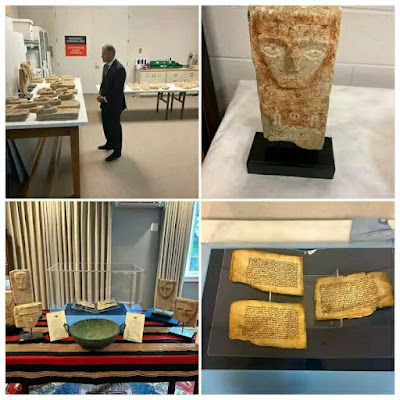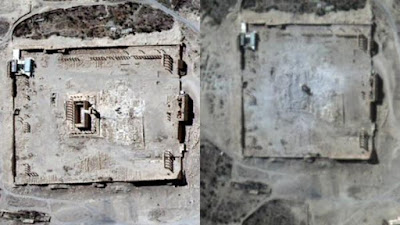As detailed in that earlier ARCA blog post, involving another potentially suspect object, Khouli moved to New York City with his family from Syria in 1992. Once in America he opened a gallery specializing in objects from the ancient world in 1995. His father had a gallery in Damascus, Syria for 35 years and his grandfather too worked in the art and antiquities trade, meaning that he should likely be well-versed in the legalities of trading in objects from the ancient world.
But knowing the law and abiding by the law, are two different things.
In 2008 and 2009 Khouli arranged for the purchase and smuggling of a series of Egyptian antiquities, exported from Dubai in the United Arab Emirates and then smuggled into the United States under false declarations to the US Customs authorities concerning the country of origin and the value of the antiquities. The illicit objects included a set of Egyptian funerary boats, a Greco-Roman style Egyptian sarcophagus, a three-part nesting coffin set, which, according to its hieroglyphics, may have belonged to “Shesepamuntayesher” from the Saite period or 26th Dynasty, and several Egyptian limestone figurines. The contents on the shipping labels and customs paperwork supplied for the imported items were intentionally mislabeled as “antiques,” “wood panels,” and a “wooden painted box.”
Yet looking at the documentation for Khouli's recent auction of the Palmyrene limestone funerary sculpture also raises some questions. At the time of the 2008-09 conviction, Khouli provided the purchasing collector with false provenance for the trafficked Egyptian antiquities; documents which stated that the objects were part of a private collection that his father had assembled in Israel in the 1960s.
Under the listing for the Palmyrene limestone funerary bust both websites list:
"Private NYC Collection acquired From Israel 10-03-2011 with original Export License from Israel" for the object's provenance. Along with the written detail, each auction included a reassuring photo for the would-be bidder, a rumpled document written in Hebrew and English that states that the object had been exported from Israel through Sami Taha, an antiquarian and numismatist whose website states he is
"serving Jerusalem and the world's market for antiquities from the Holy Land by authority of the Israel Antiquities Authority."
Sami Taha's business is operated with the following details:
Twitter Profile: @BiblicalArtifas
eBay Seller Profile:
biblicalartifacts.jerusalem
Until August 2016 he listed himself as an authorised Antiquities Dealer, License No.144 *
Ancient Art of the Holy Land
45 Jaffa Gate, opposite David Citadel entrance
PO Box. 14646
Jerusalem 9114601, Israel
The physical location for his shop has since closed though he is still selling actively on the web.
* Note: No copy of this dealer's Israeli Antiquities Authority license has been provided on Taha's website.
If the provenance document provided during the sale for this limestone funerary bust is to be believed, the object was shipped from Israel to a collector in Europe. Interestingly, the name listed as the importer also shows up on other antiquities traceable to Khouli as the collector listed in the provenance of at least three objects being sold or which have already been sold through various online auction websites. This makes these objects equally questionable.
But what does an Israeli export authorisation form actually look like?
Below is an example of an authentic Israeli-issued IAA export approval document issued in 2011 (below left). The document next to it is the one provided by Khouli for the Palmyra bust (below right).
Notice that the documentation provided for the purported Syrian object does not identify the export authority in the header, nor is it rubber-stamped or signed.
But why didn't the limestone funerary bust, allegedly from Palmyra, have any documentation from its country of origin, Syria?
Because there isn't any. The general export of antiquities is altogether banned in Syria in all but the rarest of circumstances and the country's cultural heritage is protected by numerous national laws. A review of the
ICOM red list for Syria shows that authentic funerary busts from Palmyra would likely be classified as a movable antiquity, considered immovable in cases where they are parts or decorations of immovable antiquities (such as gravesites) and covered under the following national rulings:
Decree-Law No. 84 of the Civil Code regarding archaeological objects
covered by specific laws - 18 May 1949
Legislative Decree No. 148 of the Penal Code regarding the destructions
of historical monuments - 22 May 1949
Legislative Decree No. 222 on the Antiquities regime in Syria - 26 October 1963, as amended by the Antiquities Law - 5 April 1999
NOTE: Legislative Decree No. 222 encompasses previous national legislation
regarding the protection of cultural heritage:
Legislative Decree No. 295 - 2 December 1969
Legislative Decree No. 296 - 2 December 1969
Legislative Decree No. 333 - 23 December 1969
Law No. 38 on Customs - 6 July 2006
Decree-Law No. 107 regarding local administration - 23 August 2011
Article 69 of the Syrian Antiquities Law specifically provides that an export license may only be granted with regard to antiquities that are to be exchanged with museums and other scientific institutions, and with regard to antiquities given to an organization or mission after excavations are finished. Neither of these circumstances appear to be the case with the auctioned funerary bust, making the fact that the object has no other substantiating paperwork, prior to 1963, all the more suspicious.
So if the object is authentic, then who moved the bust from Syria to New York, and how and is it authentic?
ArchaeologyIN (The Archaeology Information Network) has notified Walid Al-Asad, the former director of antiquities and museums in Palmyra on 28 November about the object's upcoming sale and Al-Asad stated that at first glance the auction photo appears to meet the artistic specifications of a Palmyrene limestone funerary bust. On this basis, ArchaeologyIN formally notified Dr. Maamoun Abdulkarim, Director General, Directorate General of Antiquities & Museums (DGAM) in Syria of the potentially suspicious item.
Questioning its entry into the United States on the basis of the material supplied by the seller, ARCA in turn contacted U.S. Immigration and Customs Enforcement (ICE) in New York about its concerns regarding the object's limited import/export paperwork and the bust's purported export provenance from Israel via possibly Oslo.
But small organisations and understaffed source countries, acting alone or in cooperation, cannot tackle all of the triangulations between looters, smugglers, transit countries, dealers and potential buyers. Without the active support of the art collecting community itself, the problem of illicit trafficking will always be a
catch me if you can game of cat and mouse.
The appearance of paperwork, should never replace a buyer's own due diligence.
If crafty antiquities dealers can write anything they want about an object's collecting history when promoting their wares for an auction listing then it's ultimately up to the individual collector/buyer to do their own homework before ethically committing to the purchase ancient art. This is all the more true of antiquities whose purported origins are from conflict-ridden war zones such as Palmyra.
The antiquities dealer says he has an export license? Do you, as the potential buyer, know what type of actual import and export documentation an ancient object would need to have to have legally passed out of the object's source country and into the hands of the seller in the dealer's destination country? Do you as a collector know enough about the heritage protection laws in the country where the object originates to make sure what you are purchasing isn't contributing to a country's instability?
As a morally principled art buyer, who are you are entrusting your purchase to? Do you know the background and ethics of the antiquities dealer you are purchasing an object from? Has that person been involved in dishonest trading in the past? Have they falsified documentation previously in furtherance of laundering illicit objects through the licit market either for greed or to satisfy collector's demands?
As a buyer, investing in ancient art, the antiquities collector has the right, but also the responsibility, to ask to see all export documentation and to verify that the object's provenance claims are true, before any money changes hands.
Ethical antiquities dealer with a clean object should have no problem with the close scrutiny. If they do, or if the deal seems too good to be true, then it most likely is.
For more information on this particular dealer's past history ARCA recommends the following Dr. David Gill's
Looting Matters posts as well as the comprehensive federal case reporting of
Rick St. Hilaire which can be found here.
By: Lynda Albertson
 art restitution,Holyland Numismatics,illegal trafficking,Morris Khouli,Mousa Khouli,Nefertiti Eastern Sculptures Trading,Palmyra,Palmyra Heritage,Windsor Antiquities,Yemen
art restitution,Holyland Numismatics,illegal trafficking,Morris Khouli,Mousa Khouli,Nefertiti Eastern Sculptures Trading,Palmyra,Palmyra Heritage,Windsor Antiquities,Yemen
 No comments
No comments









































